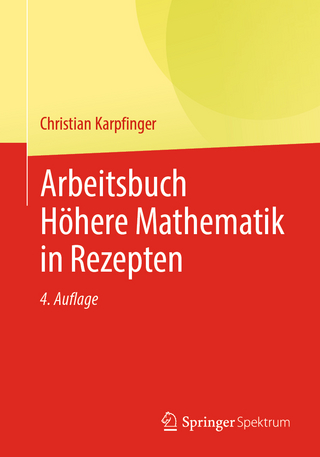Cyclotomic Fields I and II
Springer-Verlag New York Inc.
978-0-387-96671-7 (ISBN)
1 Character Sums.- 1. Character Sums over Finite Fields.- 2. Stickelberger’s Theorem.- 3. Relations in the Ideal Classes.- 4. Jacobi Sums as Hecke Characters.- 5. Gauss Sums over Extension Fields.- 6. Application to the Fermat Curve.- 2 Stickelberger Ideals and Bernoulli Distributions.- 1. The Index of the First Stickelberger Ideal.- 2. Bernoulli Numbers.- 3. Integral Stickelberger Ideals.- 4. General Comments on Indices.- 5. The Index for k Even.- 6. The Index for k Odd.- 7. Twistings and Stickelberger Ideals.- 8. Stickelberger Elements as Distributions.- 9. Universal Distributions.- 10. The Davenport-Hasse Distribution.- Appendix. Distributions.- 3 Complex Analytic Class Number Formulas.- 1. Gauss Sums on Z/mZ.- 2. Primitive L-series.- 3. Decomposition of L-series.- 4. The (± 1)-eigenspaces.- 5. Cyclotomic Units.- 6. The Dedekind Determinant.- 7. Bounds for Class Numbers.- 4 The p-adic L-function.- 1. Measures and Power Series.- 2. Operations on Measures and Power Series.- 3. The Mellin Transform and p-adic L-function.- Appendix. The p-adic Logarithm.- 4. The p-adic Regulator.- 5. The Formal Leopoldt Transform.- 6. The p-adic Leopoldt Transform.- 5 Iwasawa Theory and Ideal Class Groups.- 1. The Iwasawa Algebra.- 2. Weierstrass Preparation Theorem.- 3. Modules over ZP[[X]].- 4. Zp-extensions and Ideal Class Groups.- 5. The Maximal p-abelian p-ramified Extension.- 6. The Galois Group as Module over the Iwasawa Algebra.- 6 Kummer Theory over Cyclotomic Zp-extensions.- 1. The Cyclotomic Zp-extension.- 2. The Maximal p-abelian p-ramified Extension of the Cyclotomic Zp-extension.- 3. Cyclotomic Units as a Universal Distribution.- 4. The Iwasawa-Leopoldt Theorem and the Kummer-Vandiver Conjecture.- 7 Iwasawa Theory of Local Units.- 1. The Kummer-Takagi Exponents.- 2.Projective Limit of the Unit Groups.- 3. A Basis for U(x) over A.- 4. The Coates-Wiles Homomorphism.- 5. The Closure of the Cyclotomic Units.- 8 Lubin-Tate Theory.- 1. Lubin-Tate Groups.- 2. Formal p-adic Multiplication.- 3. Changing the Prime.- 4. The Reciprocity Law.- 5. The Kummer Pairing.- 6. The Logarithm.- 7. Application of the Logarithm to the Local Symbol.- 9 Explicit Reciprocity Laws.- 1. Statement of the Reciprocity Laws.- 2. The Logarithmic Derivative.- 3. A Local Pairing with the Logarithmic Derivative.- 4. The Main Lemma for Highly Divisible x and ? = xn.- 5. The Main Theorem for the Symbol ?x, xn?n.- 6. The Main Theorem for Divisible x and ? = unit.- 7. End of the Proof of the Main Theorems.- 10 Measures and Iwasawa Power Series.- 1. Iwasawa Invariants for Measures.- 2. Application to the Bernoulli Distributions.- 3. Class Numbers as Products of Bernoulli Numbers.- Appendix by L. Washington: Probabilities.- 4. Divisibility by l Prime to p: Washington’s Theorem.- 11 The Ferrero-Washington Theorems.- 1. Basic Lemma and Applications.- 2. Equidistribution and Normal Families.- 3. An Approximation Lemma.- 4. Proof of the Basic Lemma.- 12 Measures in the Composite Case.- 1. Measures and Power Series in the Composite Case.- 2. The Associated Analytic Function on the Formal Multiplicative Group.- 3. Computation of Lp(1, x) in the Composite Case.- 13 Divisibility of Ideal Class Numbers.- 1. Iwasawa Invariants in Zp-extensions.- 2. CM Fields, Real Subfields, and Rank Inequalities.- 3. The l-primary Part in an Extension of Degree Prime to l.- 4. A Relation between Certain Invariants in a Cyclic Extension.- 5. Examples of Iwasawa.- 6. A Lemma of Kummer.- 14 P-adic Preliminaries.- 1. The p-adic Gamma Function.- 2. The Artin-Hasse Power Series.- 3. AnalyticRepresentation of Roots of Unity.- Appendix: Barsky’s Existence Proof for the p-adic Gamma Function.- 15 The Gamma Function and Gauss Sums.- 1. The Basic Spaces.- 2. The Frobenius Endomorphism.- 3. The Dwork Trace Formula and Gauss Sums.- 4. Eigenvalues of the Frobenius Endomorphism and the p-adic Gamma Function.- 5. p-adic Banach Spaces.- 16 Gauss Sums and the Artin-Schreier Curve.- 1. Power Series with Growth Conditions.- 2. The Artin-Schreier Equation.- 3. Washnitzer-Monsky Cohomology.- 4. The Frobenius Endomorphism.- 17 Gauss Sums as Distributions.- 1. The Universal Distribution.- 2. The Gauss Sums as Universal Distributions.- 3. The L-function at s = 0.- 4. The p-adic Partial Zeta Function.- Appendix by Karl Rubin.- The Main Conjecture.- 1. Setting and Notation.- 2. Properties of Kolyvagin’s “Euler System”.- 3. An Application of the Chebotarev Theorem.- 5. The Main Conjecture.- 6. Tools from Iwasawa Theory.- 7. Proof of Theorem 5.1.- 8. Other Formulations and Consequences of the Main Conjecture.
| Reihe/Serie | Graduate Texts in Mathematics ; 121 |
|---|---|
| Mitarbeit |
Assistent: Karl Rubin |
| Zusatzinfo | XVII, 436 p. |
| Verlagsort | New York, NY |
| Sprache | englisch |
| Maße | 155 x 235 mm |
| Themenwelt | Mathematik / Informatik ► Mathematik ► Algebra |
| Mathematik / Informatik ► Mathematik ► Arithmetik / Zahlentheorie | |
| Mathematik / Informatik ► Mathematik ► Wahrscheinlichkeit / Kombinatorik | |
| ISBN-10 | 0-387-96671-4 / 0387966714 |
| ISBN-13 | 978-0-387-96671-7 / 9780387966717 |
| Zustand | Neuware |
| Informationen gemäß Produktsicherheitsverordnung (GPSR) | |
| Haben Sie eine Frage zum Produkt? |
aus dem Bereich




